Summary
We have been carrying out a series of investigations aimed at helping to define sites and situations where direct seeding, as a method for woodland creation and regeneration, is more likely to succeed.
What affects the success of direct seeding?
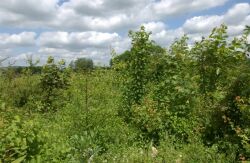
A former arable field direct-sown with a range of lowland trees and shrubs
Although, it has not been extensively practiced in Britain, direct seeding has several potential advantages over conventional planting or natural regeneration. Successful direct seeding depends on the:
- Quality of seed
- Quantity of seed sown
- Site selection
- Soil preparation.
Recent work has shown that the technique can be successfully used for creating new woodland on reclaimed or former-agricultural land, but it has not been successful at woodland sites (Willoughby et al. 2004).
Limiting factors
Seed germination and seedling establishment are precarious stages in the life cycle of plants (Harper 1977). A range of factors can kill seeds and seedlings and these usually vary from place-to-place and year-to-year; this makes predicting outcomes difficult and contributes to the potential unreliability of direct seeding. These factors include:
- Soil condition and temperature
- Predation – in woodlands one of the main limiting factors is seed predation by seed-eating animals.
Sowing rates
Even in new planting situations recommended sowing rates are very high, typically 100 000 to 200 000 seeds to hectare, in an attempt to overcome early losses.
The need to sow at relatively high rates reduces the economic advantage that direct seed seedling might have over conventional planting, and may preclude inclusion of more expensive seed in direct seeding mixtures.
If sowing rates are to be reduced, reliability increased, and the technique extended to other situations, then it is important to find out more about the causes of losses and explore ways of overcoming potential limiting factors.
Contact
For further information contact:
Richard Jinks
Forest Research
Alice Holt Lodge
Farnham
Surrey GU10 4LH
Tel: 01420 22255
Fax:01420 23653
E-mail: richard.jinks@forestry.gsi.gov.uk
Affect of soil conditions and temperature on direct sown seed
Soil conditions
Our recent studies with ash and sycamore seeds have shown the importance of soil conditions on survival of direct sown tree seed (Jinks et al. 2005). Seed of both species are particularly sensitive to soil waterlogging, so seedling emergence on wet areas of our sites is much lower than at drier ones.
This local variation diversifies seedling density and composition across a site, which enhances the ‘natural’ appearance of new woodland established by direct sowing species mixtures compared with traditional transplanting methods.
Such variation is a potential advantage for creating native woodland, but might be a disadvantage when considering direct seeding as a way of establishing more commercial crops where it is more desirable to minimise such variation.
Soil temperature
We’ve also found that the process of germination and seedling emergence is particularly sensitive to high soil temperatures in spring and early summer. Results so far suggest that emergence stops once soil temperatures exceed 25oC; in some species like ash, ungerminated seeds return to dormant state and may be capable of germination the following spring.
In southern England, soil temperatures can exceed this threshold in April, so seed needs to be sown well in advance if germination is to be completed before then.
It’s not just heat and desiccation that can reduce seedling emergence, but spring frosts can also wipe out entire cohorts of newly emerged seedlings of sensitive species like ash. Basically, exposed fields are a more extreme environment for tree seedling emergence than woodland.
Current investigations into the fate of direct sown seed
Seed species
Our results so far suggest that seeds of species like oak, hazel, and beech are going to be much more vulnerable than those of shrubs or trees like ash and cherry. We are currently testing this prediction on an operational scale in a direct seeding experiment on a conifer clearfell site in Hampshire.
Seed repellents
We are also investigating ways to reduce seed loss due to predation, for example by using approved seed repellents.
Soil type and sowing depth
We are also looking at ways to reduce the detectability of vulnerable species by investigating the relationships between soil type, and safe sowing depth for reduced predation but successful seedling emergence. The importance of soil porosity for the detection of buried seeds is demonstrated in the figure below:
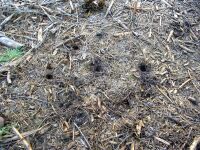
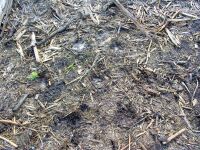
A demonstration of the effects of burial on seed removal of acorns by rodents on a clearfell site.
In the left picture, seven acorns were sown into the organic debris on a conifer clear fell site. Every acorn was removed overnight.
On the right, another set of acorns was sown into the same layer, but the holes backfilled with wet clay; these acorns remained undisturbed despite the mice probably walking across them to get the ones in the right-hand picture!
Predation of direct sown seed
Agricultural land vs. woodland sites
Removal of seeds by seed-eating birds and rodents is widely acknowledged as an important limiting factor for direct seeding.
Part of the success on agricultural sites is due to the much lower abundance of seed eating animals on these sites, where agricultural practices such as harvesting and ploughing tend to reduce population build up, compared with woodland habitat with much higher resident populations of mice.
Unfortunately, our work has shown that harvesting operations do not appear to have a similar impact on the abundance of seed eating rodent activity on woodland sites, since seed removal from test caches placed out across clear-fell sites in southern England was rapid: a matter of a few nights.
Who are the predators?
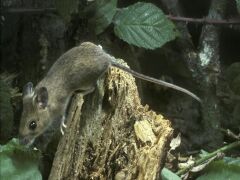
Numerous studies have shown that the principal agents of predation are small mammals in particular mice and voles.
The most common species encountered in our studies was the wood mouse (Apodemus sylvaticus) – see right, which does not hibernate in winter and needs to feed continuously to survive. Seeds form an important part of their winter diet and they not only remove seeds for immediate consumption, but also carry encountered seeds to temporary underground larders for later consumption.
The effect of seed mixes
Prior to this work, the accepted wisdom is that direct seeding is likely to fail when seed-eating rodents are present. However, this was based on experience with relatively few species such as oak, and beech that have often been sown as pure species. In contrast when direct seeding new native woodlands, seed mixes will contain at least 6, possibly up to 12, different species depending on the woodland type being established.
Studies have shown that rodents given a choice tend to prefer to remove seeds of some species over others (e.g. Kollmann et al. 1998). So it was highly likely that there would be differences in relative predation risk between the species included in direct-seeding seed mixes.
Such differences might preclude direct sowing high risk species, but still permit use of lower risk species; for example direct seeding of low risk species could be combined with planting seedlings of those at high risk, or protection treatments, such as repellents, might be focussed on the high risk category.
What are the seed preferences?
 Seeds and fruits of lowland trees and shrubs arranged in approximate order of preference by rodents.
Seeds and fruits of lowland trees and shrubs arranged in approximate order of preference by rodents.
Top: oak, beech, sycamore, and hazel.
Bottom: wayfaring-tree, wild cherry, dogwood, guilder-rose, field maple, sloe, hawthorn, and ash.
Surprisingly, there are very few studies that have studied seed preferences amongst a wide range of species – most usually concentrate on 2 or 3 species. We have carried out a series of studies with natural populations of mice to investigate predator preference amongst tree and shrub seeds that are likely to be sown for creating lowland native woodland. Results showed that there are distinct differences, but these were by no means absolute and varied somewhat between different experiments.
Aggregated results from several sites using the same seed lots of 12 species showed that the most highly preferred species is oak. Whenever a patch of mixed seeds was encountered, the acorns were always removed first and completely.
The next three species ranked in order of preference were beech, sycamore and hazel; these were usually removed after the acorns, and were often (but not always) removed completely.
At the other end of the preference scale came ash and hawthorn seeds which often remained untouched, or when they were partially removed, they were the last species to go.
Preference for seeds of the remaining species was more variable in terms of the order and extent to which they were removed.
This work is not completed and further details can be found in a research note
The effect of burying directly sown seed
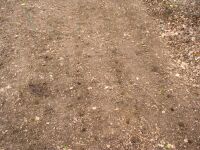
A small plot sown in early winter with four rows of hazel fruits which have rapidly been encountered and removed. Other species such as ash sown in adjacent plots remained untouched throughout winter.
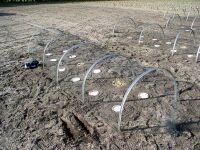
A replicate of an experiment containing seeds of 12 species buried in bowls of sand. After two nights, only acorns and hazel nuts have been searched out, dug up and removed.
The above results suggest that species producing nuts, and sycamore, are likely to be much more vulnerable to predation than other tree and shrub seeds. Results from experiments using buried seeds support this prediction.
Burying seed has two effects on seed predation:
- It can reduce the chances of seed being detected by for example masking smell, but this will depend on factors like burial depth, and the porosity of the soil.
- It increases the time needed to locate and remove seeds compared with freely-available seed on the surface.
For example, using seeds in buried in sand, only acorns, beech and hazel nuts were removed, the remaining species were unpredated, despite exploratory digging.
On a larger-scale trial using direct sown beech, hazel, field maple, ash, hawthorn and dogwood, excavation of sown seeds was confined principally to hazel and beech (average 70% seed sites dug up), compared with less than 15% for the other species; and these differences were reflected in seedling emergence where only a tiny proportion of sown hazel and beech emerged compared with 30% of the other species.
Direct sown seed – references
Harper,J.L. 1977. Population Biology of Plants. Academic Press, London.
Jinks,R.L., Willoughby,I., and Baker,C. 2005. Direct seeding of ash (Fraxinus excelsior L.) and sycamore (Acer pseudoplatanus L.): the effects of sowing date, site conditions and pre-emergent herbicides on seedling emergence and survival. Forest Ecology and Management. In review.
Kollmann,J., Coomes,D.A., and White,S.M. 1998. Consistencies in post-dispersal seed predation of temperate fleshy-fruited species amongst seasons, years and sites. Functional Ecology 12: 683-690.
Willoughby,I., Jinks,R., Gosling,P., and Kerr,G. 2004. Creating new broadleaved woodlands by direct seeding (PDF-647 KB). Forestry Commission, Edinburgh.
